
Sir James Thornhill was an English painter of historical subjects working in the Italian baroque tradition. He was responsible for some large-scale schemes of murals, including the "Painted Hall" at the Royal Hospital, Greenwich, the paintings on the inside of the dome of St Paul's Cathedral, and works at Chatsworth House and Wimpole Hall.

Sir George Scharf KCB was a British art critic, illustrator, and director of the National Portrait Gallery.

The Rape of the Sabine Women, also known as the Abduction of the Sabine Women or the Kidnapping of the Sabine Women, was an incident in the legendary history of Rome in which the men of Rome committed a mass abduction of young women from the other cities in the region. It has been a frequent subject of painters and sculptors, particularly since the Renaissance.
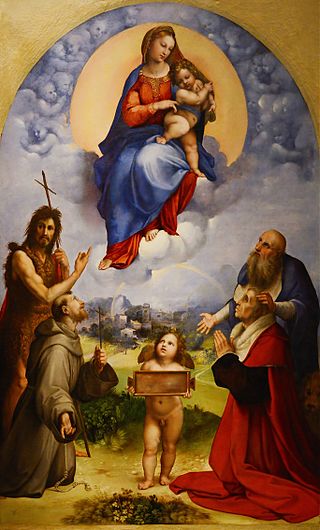
The Madonna of Foligno is a painting by the Italian High Renaissance painter Raphael, executed c. 1511–1512. First painted on wood panel, it was later transferred to canvas.

Joseph van Severdonck (1819–1905) was a Belgian artist.

St. George or St. George and the Dragon is a small painting by the Italian Renaissance artist Raphael, executed c. 1503-1505. It is housed in the Louvre in Paris. A later version of the same subject is the St. George in the National Gallery of Art in Washington, D.C.
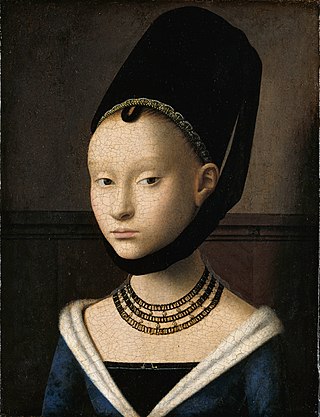
Portrait of a Young Girl is a small oil-on-oak panel painting by the Early Netherlandish painter Petrus Christus. It was completed towards the end of his life, between 1465 and 1470, and is held in the Gemäldegalerie, Berlin. It marks a major stylistic advance in contemporary portraiture; the girl is set in an airy, three-dimensional, realistic setting, and stares out at the viewer with a complicated expression that is reserved, yet intelligent and alert.

Fabrizio Santafede or Fabrizio Santaféde was an Italian painter known for his altarpieces. He painted in a style that rejected the Mannerism popular in the Naples of his time and evident in the works of Francesco Curia.
Wynne Ellis (1790–1875) was a wealthy British haberdasher, politician and art collector.

Louis Mayer, born Ludwig Hartmann Mayer, was a German landscape painter and brother to the poet Karl Mayer.
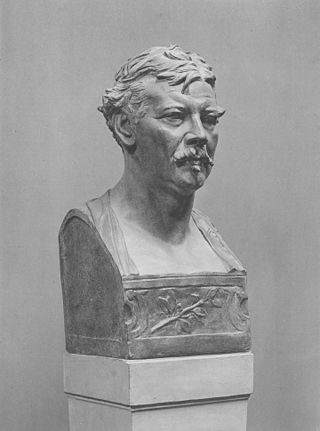
Leopold Carl Müller was an Austrian genre painter noted for his Orientalist works.

Blaise Alexandre Desgoffe was a French painter who specialized in meticulously finished still-life paintings. He was the nephew of the painter Alexandre Desgoffe and father of the painter Jules Desgoffe.

Félix-Joseph Barrias was a French painter. He was well known in his day for his paintings of religious, historical or mythical subjects, but has now been largely forgotten. Artists who trained in his studio and went on to achieve fame include Edgar Degas, Gustave Achille Guillaumet and Henri Pille.
Lina von Perbandt was a German landscape painter and member of the Düsseldorf school of painting
Edmund Lilly was an English painter, most notable for his portraits.
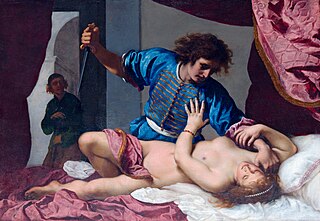
The Rape of Lucretia is any of several paintings, variations of the same subject, which are usually attributed to either Felice Ficherelli or Guido Cagnacci and dated to the late 1630s or about 1640.

Lucretia and Tarquin is a 1663 oil painting by Luca Giordano of the legendary rape of Lucretia by Sextus Tarquin, as told by Livy and Ovid, which is now in the Museo di Capodimonte in Naples.
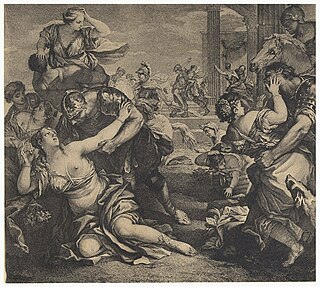
The Rape of the Sabine Women may refer to at least eight paintings attributed to Luca Giordano or his workshop, all of which depict the legendary rape of the Sabine women.

The Manna, formerly titled The Israelites Gathering Manna in the Desert, is an oil painting by Poussin, dated to 1638 or 1639, which is now in the Louvre, Paris. The work is regarded as one of Poussin's most ambitious.

The legendary rape of the Sabine women is the subject of two oil paintings by Nicolas Poussin. The first version was painted in Rome about 1634 or 1635 and is now in the Metropolitan Museum of Art in New York City, catalogued as The Abduction of the Sabine Women. The second, painted in 1637 or 1638, is in the Louvre in Paris, catalogued as L'enlèvement des Sabines.


















